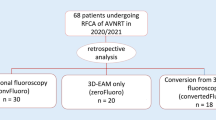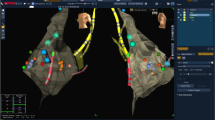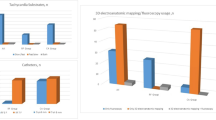Abstract
Background
Radiofrequency ablation (RFA) and cryo-ablation (CRA) have been traditionally performed with fluoroscopy which exposes patients and medical staff to the potential harmful effects of the X-ray. Therefore, we aimed to assess the feasibility, safety, and effectiveness of RFA and CRA of atrioventricular nodal reentry tachycardia (AVNRT) guided by the three-dimensional (3D) electro-anatomical mapping (EAM) system without the use of fluoroscopy.
Methods
We analyzed 168 consecutive patients with AVNRT, 62 of whom were under 19 years of age (128 in RFA (age 34.04 ± 21.0 years) and 40 in CRA (age 39.41 ± 22.8 years)). All procedures were performed completely without the use of the fluoroscopy and with the 3D EAM system.
Results
The acute success rates (ASR) of the two ablation methods were very high and similar (for RFA 126/128 (98.4%) and for CRA 40/40 (100%); p = 0.43). Total procedural time (TPT) was similar in RFA and CRA groups (75.04 ± 42.31 min and 73.12 ± 30.54 min, respectively; p = 0.79). Recurrence rates (1 (2.5%) and 8 (6.25%); p = 0.35) were similar. There were no complications associated with procedures in either group. In pediatric group, ASR (61/62 (98.38%) and 105/106 (99.05%), respectively; p = 0.69) and TPT (75.16 ± 42.2 min and 74.23 ± 38.3 min, respectively; p = 0.88) were similar to the adult group. High ASR was observed with both ablation methods (for RFA 49/50, 98%, and for CRA 12/12, 100%; p = 0.62] with very high arrhythmia-free survival rates (for RFA 98% and for CRA 100%; p = 0.62).
Conclusion
Based on these results, it can be suggested that fluoroless RFA or CRA guided by the 3D EAM system can be routinely performed in all patients with AVNRT without compromising safety, efficacy, or duration of the procedure.




Similar content being viewed by others
Availability of data and material
All data generated and analyzed during this study are included in this published article or can be provided upon request.
References
Blomström-Lundqvist C, Sheinman MM, Aliot EM, Alpert JS, Calkins H, Camm AJ, et al. ACC/AHA/ESC guidelines for the management of patients with supraventricular arrhythmias--executive summary: a report of the American college of cardiology/American heart association task force on practice guidelines and the European society of cardiology committee for practice guidelines. J Am Coll Cardiol. 2003;42:1493–531.
Calkins H, Yong P, Miller JM, Olshansky B, Carlson M, Saul JP, et al. Catheter ablation of accessory pathways, atrioventricular nodal reentrant tachycardia, and the atrioventricular junction: final resuls of a prospective, multicenter clinical trial. Circulation. 1999;99:262–70.
Jackman WM, Beckman KJ, McClelland JH, Wang X, Friday KJ, Roman CA, et al. Treatment of supraventricular tachycardia due to atrioventricular nodal reentry by radiofrequency catheter ablation of slow-pathway conduction. N Engl J Med. 1992;327:313–8.
Santangeli P, Proietti R, Di Biase L, Bai R, Natale A. Cryoablation versus radiofrequency ablation of atrioventricular nodal reentrant tachycardia. J Interv Card Electrophysiol. 2014;39:111–9.
Hanninen M, Yeung-Lai-Wah N, Massel D, Gula LJ, Skanes AC, Yee R, et al. Cryoablation versus RF ablation for AVNRT: a meta-analysis and systematic review. J Cardiovasc Electrophysiol. 2013;24:1354–60.
Papagiannis J, Papadopoulou K, Rammos S, Katritsis D. Cryoablation versus radiofrequency ablation for atrioventricular nodal reentrant tachycardia in children: longterm results. Hell J Cardiol. 2010;51:122–6.
Spector P, Reynolds MR, Calkins H, Sondhi M, Xu Y, Martin A, et al. Metaanalysis of ablation of atrial flutter and supraventricular tachycardia. Am J Cardiol. 2009;104:671–7.
Cappato R, Kuck KH. Catheter ablation in the year 2000. Curr Opin Cardiol. 2000;15:29–40.
Ait-Ali L, Andreassi MG, Foffa I, Spadoni I, Vano E, Picano E. Cumulative patient effective dose and acute radiation-induced chromosomal DNA damage in children with congenital heart disease. Heart. 2010;96:269–74.
Kovoor P, Ricciardello M, Collins L, Uther JB, Ross DL. Risk to patients from radiation associated with radiofrequency ablation for supraventricular tachycardia. Circulation. 1998;98:1534–40.
Picano E, Vañó E, Rehani MM, Cuocolo A, Mont L, Bodi V, et al. The appropriate and justified use of medical radiation in cardiovascular imaging: a position document of the ESC associations of cardiovascular imaging, percutaneous cardiovascular interventions and electrophysiology. Eur Heart J. 2014;35:665–72.
Gellis LA, Ceresnak SR, Gates GJ, Nappo L, Pass RH. Reducing patient radiation dosage during pediatric SVT ablations using an “ALARA” radiation reduction protocol in the modern fluoroscopic era. Pacing Clin Electrophysiol. 2013;36:688–94.
Jan M, Žižek D, Rupar K, Mazić U, Kuhelj D, Lakič N, et al. Fluoroless catheter ablation of various right and left sided supraventricular tachycardias in children and adolescents. Int J Card Imaging. 2016;32:1609–16.
Balli S, Kucuk M, Orhan Bulut M, Kemal Yucel I, Celebi A. Transcatheter cryoablation procedures without fluoroscopy in pediatric patients with atrioventricular nodal reentrant tachycardia: a single-center experience. Acta Cardiol Sin. 2018;34:337–43.
Scaglione M, Ebrille E, Caponi D, Blandino A, DI Donna P, Siboldi A, et al. Single center experience of fluoroless AVNRT ablation guided by electroanatomic reconstruction in children and adolescents. Pacing Clin Electrophysiol. 2013;36:1460–7.
Kozluk E, Rodkiewicz D, Piątkowska A, Opolski G. Safety and efficacy of cryoablation without the use of fluoroscopy. Cardiol J. 2018;25:327–32.
Seizer P, Bucher V, Frische C, Heinzmann D, Gramlich M, Müller I, et al. Efficacy and safety of zero-fluoroscopy ablation for supraventricular tachycardias. Use of optional contact force measurement for zero-fluoroscopy ablation in a clinical routine setting. Herz. 2016;41:241–5.
Giaccardi M, Del Rosso A, Guarnaccia V, Ballo P, Mascia G, Chiodi L, et al. Nearzero x-ray in arrhythmia ablation using a 3-dimensional electroanatomic mapping system: a multicenter experience. Heart Rhythm. 2016;13:150–6.
Stec S, Śledź J, Mazij M, Raś M, Ludwik B, Chrabąszcz M, et al. Feasibility of implementation of a “simplified, no-X-ray, no-lead apron, two-catheter approach” for ablation of supraventricular arrhythmias in children and adults. J Cardiovasc Electrophysiol. 2014;25:866–74.
Haegeli LM, Stutz L, Mohsen M, Wolber T, Brunckhorst C, On CJ, et al. Feasibility of zero or near zero fluoroscopy during catheter ablation procedures. Cardiol J. 2019;26:226–32.
Casella M, Dello Russo A, Pelargonio G, Del Greco M, Zingarini G, Piacenti M, et al. Near zerO fluoroscopic exPosure during catheter ablAtion of supRavenTricular arrhYthmias: the NO-PARTY multicentre randomized trial. Europace. 2016;18:1565–72.
Earley MJ, Showkathali R, Alzetani M, Kistler PM, Gupta D, Abrams DJ, et al. Radiofrequency ablation of arrhythmias guided by non-fluoroscopic catheter location: a prospective randomized trial. Eur Heart J. 2006;27:1223–9.
Razminia M, Willoughby MC, Demo H, Keshmiri H, Wang T, D'Silva OJ, et al. Fluoroless catheter ablation of cardiac arrhythmias: a 5-year experience. Pacing Clin Electrophysiol. 2017;40:425–33.
Santoro A, Di Clemente F, Baiocchi C, Zacà V, Bianchi C, Bellini C, et al. From near-zero to zero fluoroscopy catheter ablation procedures. J Cardiovasc Electrophysiol. 2019;30:2397–404.
Kalbfleisch SJ, Strickberger SA, Williamson B, Vorperian VR, Man C, Hummel JD, et al. Randomized comparison of anatomic and electrogram mapping approaches to ablation of the slow pathway of atrioventricular node reentrant tachycardia. J Am Coll Cardiol. 1994;23:716–23.
Katritsis DG, Zografos T, Siontis KC, Giannopoulos G, Muthalaly RG, Liu Q, et al. Endpoints for successful slow pathway catheter ablation in typical and atypical atrioventricular nodal re-entrant tachycardia: a contemporary, Multicenter Study. JACC Clin Electrophysiol. 2019;5:113–9.
Yang L, Sun G, Chen X, Chen G, Yang S, Guo P, et al. Meta-analysis of zero or near-zero fluoroscopy use during ablation of cardiac arrhythmias. Am J Cardiol. 2016;118:1511–8.
Eryazici PL, Razminia M, D'Silva O, Chavez JR, Ciftci FD, Turner M, et al. Time-limited cryomapping during tachycardia: improved long-term outcomes for cryoablation of AVNRT. J Interv Card Electrophysiol. 2016;47:125–31.
Author information
Authors and Affiliations
Contributions
All authors (MJ, MY, TPK, DŽ, DK, AP, NL) made substantial contribution to the design of the study, acquisition, analysis, and interpretation of data. All authors (MJ, MY, TPK, DŽ, DK, AP, NL) also actively participated in drafting the manuscript, its final revisions, and corrections. All authors (MJ, MY, TPK, DŽ, DK, AP, NL) read and approved the final version of the manuscript. All authors (MJ, MY, TPK, DŽ, DK, AP, NL) agree to be personally accountable for their personal contributions to the manuscript.
Corresponding author
Ethics declarations
Conflicts of interest
The authors declare that they have no conflict of interest.
Ethics approval and consent to participate
The study complies with the Declaration of Helsinki. The fluoroless approach to catheter ablation was approved by the National Medical Ethics Committee (Komisija za medicinsko etiko Republike Slovenije).
Informed consent
All patients (or their parents in case of pediatric patients) gave written informed consent before ablation procedures were performed.
Consent for publication
Not applicable.
Additional information
Publisher’s note
Springer Nature remains neutral with regard to jurisdictional claims in published maps and institutional affiliations.
Rights and permissions
About this article
Cite this article
Jan, M., Yazici, M., Kalinšek, T.P. et al. Fluoroless radiofrequency and cryo-ablation of atrioventricular nodal reentry tachycardia in adults and children: a single-center experience. J Interv Card Electrophysiol 61, 155–163 (2021). https://doi.org/10.1007/s10840-020-00791-1
Received:
Accepted:
Published:
Issue Date:
DOI: https://doi.org/10.1007/s10840-020-00791-1




